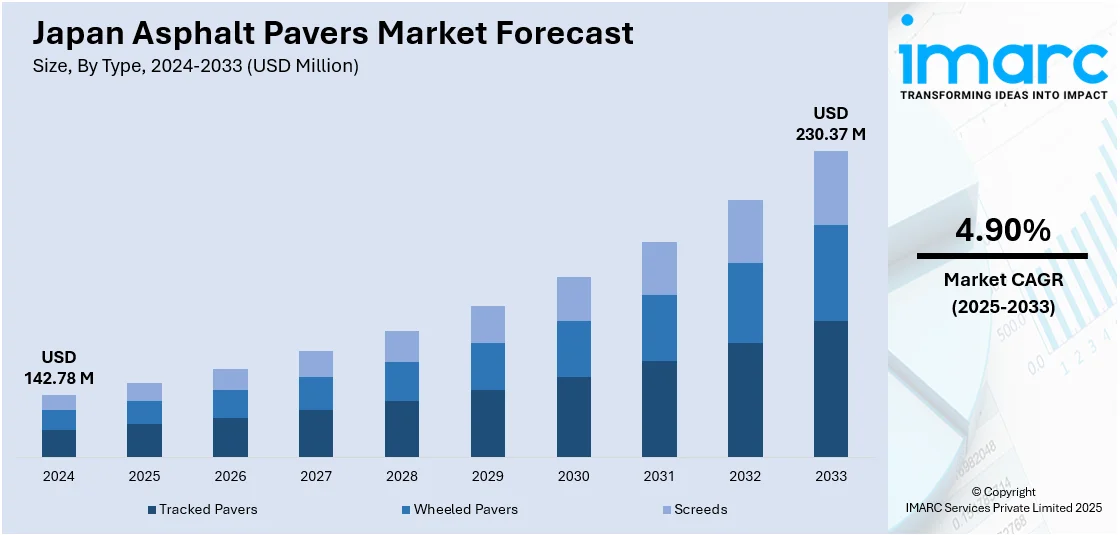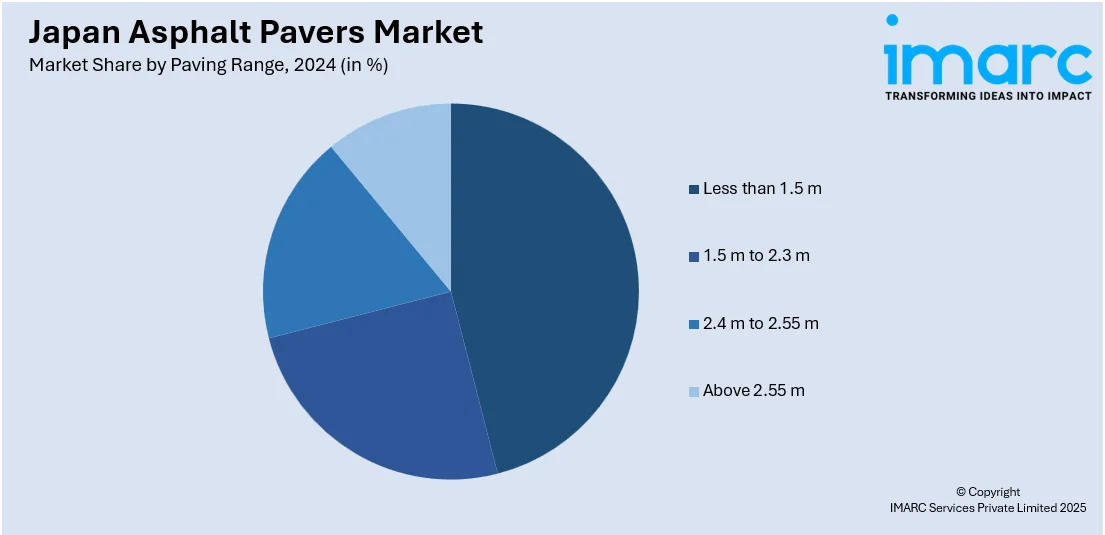
Japan Asphalt Pavers Market Size, Share, Trends and Forecast by Type, Paving Range, and Region, 2025-2033
Japan Asphalt Pavers Market Overview:
The Japan asphalt pavers market size reached USD 142.78 Million in 2024. Looking forward, IMARC Group expects the market to reach USD 230.37 Million by 2033, exhibiting a growth rate (CAGR) of 4.90% during 2025-2033. The market is being shaped by rising demand for operator-safe, automated machinery and growing international adoption of Japanese road technologies. These trends, driven by safety standards and export potential, are expected to positively influence Japan asphalt pavers market share in the coming years.
|
Report Attribute
|
Key Statistics
|
|---|---|
|
Base Year
|
2024 |
|
Forecast Years
|
2025-2033
|
|
Historical Years
|
2019-2024
|
| Market Size in 2024 | USD 142.78 Million |
| Market Forecast in 2033 | USD 230.37 Million |
| Market Growth Rate 2025-2033 | 4.90% |
Japan Asphalt Pavers Market Trends:
Operator Safety and Ergonomic Innovation
Japan's asphalt pavers market is increasingly driven by the need to ensure operator safety and ergonomic convenience. With construction projects becoming more complex and long working hours common on infrastructure sites, paving machine manufacturers are focusing on features that reduce physical strain, streamline control systems, and enhance visibility. The push toward safer working environments is not only driven by regulatory compliance but also by the industry's recognition that operator well-being directly impacts performance quality and efficiency. Automated features, smart controls, and intuitive user interfaces are gradually becoming standard expectations. In August 2024, Vögele launched its Dash 5 Asphalt Paver series with a suite of features focused on improving operator safety. Key additions included ground-level commissioning via the Paver Access Control (PAC) function, integrated LED lighting for better visibility during night work, and smart automation for screed and hardtop operations. These upgrades allowed for safer machine startup and shutdown, reduced the chances of error, and ensured clear visual access to all essential points during operation. The introduction of these systems marked a significant shift in equipment design philosophy, reinforcing operator comfort as a core product feature. As this trend spreads, Japanese manufacturers are expected to incorporate similar designs, advancing safety and usability in domestic paver models.

Global Recognition of Japanese Road Technology
The growing acceptance of Japanese road-building methods in overseas markets is becoming a key growth driver for Japan's asphalt pavers market. With infrastructure needs expanding in developing regions and an increasing focus on sustainable, cost-effective construction, Japan's long-established technologies are gaining attention abroad. These systems are known for blending durability with environmental benefits, making them attractive for regions facing both budgetary and ecological constraints. Strategic international collaborations, pilot projects, and governmental partnerships are facilitating this cross-border knowledge transfer. In October 2024, SAKAI's Cement-Asphalt Emulsion (CAE) Method—developed in Japan and used since the 1980s—received official approval from Indonesia's Binamarga agency. The approval came after field demonstrations, laboratory tests, and studies under JICA's SDG Business Supporting Survey. This recognition validated the method's ability to enhance road base strength while supporting long-lasting pavement performance. It also positioned Japan as a trusted source of innovative road stabilization technologies suited to global infrastructure challenges. The success of the CAE Method abroad has opened doors for similar Japanese techniques to enter emerging markets. This trend is reinforcing Japan's role in shaping international paving standards and is expected to drive export demand for asphalt pavers and stabilization systems developed domestically, contributing to Japan asphalt pavers market growth.
Japan Asphalt Pavers Market Segmentation:
IMARC Group provides an analysis of the key trends in each segment of the market, along with forecasts at the country and regional level for 2025-2033. Our report has categorized the market based on type and paving range.
Type Insights:
- Tracked Pavers
- Wheeled Pavers
- Screeds
The report has provided a detailed breakup and analysis of the market based on the type. This includes tracked pavers, wheeled pavers, and screeds.
Paving Range Insights:

- Less than 1.5 m
- 1.5 m to 2.3 m
- 2.4 m to 2.55 m
- Above 2.55 m
A detailed breakup and analysis of the market based on the paving range have also been provided in the report. This includes less than 1.5 m, 1.5 m to 2.3 m, 2.4 m to 2.55 m, and above 2.55 m.
Regional Insights:
- Kanto Region
- Kansai/Kinki Region
- Central/ Chubu Region
- Kyushu-Okinawa Region
- Tohoku Region
- Chugoku Region
- Hokkaido Region
- Shikoku Region
The report has also provided a comprehensive analysis of all the major regional markets, which include Kanto Region, Kansai/Kinki Region, Central/ Chubu Region, Kyushu-Okinawa Region, Tohoku Region, Chugoku Region, Hokkaido Region, and Shikoku Region.
Competitive Landscape:
The market research report has also provided a comprehensive analysis of the competitive landscape. Competitive analysis such as market structure, key player positioning, top winning strategies, competitive dashboard, and company evaluation quadrant has been covered in the report. Also, detailed profiles of all major companies have been provided.
Japan Asphalt Pavers Market News:
- December 2024: Kao introduced NEWTLAC, an asphalt additive made from recycled PET bottles, in Thailand. Developed in Japan, this innovation enhanced road durability and reduced plastic waste. It positioned Japan’s asphalt paver sector as a contributor to sustainable, high-performance road construction globally.
- October 2024: SAKAI’s CAE Method for road stabilization, proven effective in Japan since the 1980s, received official approval in Indonesia. This international recognition highlighted Japan’s expertise in asphalt paving technology and supported the global adoption of its sustainable, long-lasting pavement solutions.
Japan Asphalt Pavers Market Report Coverage:
| Report Features | Details |
|---|---|
| Base Year of the Analysis | 2024 |
| Historical Period | 2019-2024 |
| Forecast Period | 2025-2033 |
| Units | Million USD |
| Scope of the Report |
Exploration of Historical Trends and Market Outlook, Industry Catalysts and Challenges, Segment-Wise Historical and Future Market Assessment:
|
| Types Covered | Tracked Pavers, Wheeled Pavers, Screeds |
| Paving Ranges Covered | Less than 1.5 m, 1.5 m to 2.3 m, 2.4 m to 2.55 m, Above 2.55 m |
| Regions Covered | Kanto Region, Kansai/Kinki Region, Central/ Chubu Region, Kyushu-Okinawa Region, Tohoku Region, Chugoku Region, Hokkaido Region, Shikoku Region |
| Customization Scope | 10% Free Customization |
| Post-Sale Analyst Support | 10-12 Weeks |
| Delivery Format | PDF and Excel through Email (We can also provide the editable version of the report in PPT/Word format on special request) |
Key Questions Answered in This Report:
- How has the Japan asphalt pavers market performed so far and how will it perform in the coming years?
- What is the breakup of the Japan asphalt pavers market on the basis of type?
- What is the breakup of the Japan asphalt pavers market on the basis of paving range?
- What is the breakup of the Japan asphalt pavers market on the basis of region?
- What are the various stages in the value chain of the Japan asphalt pavers market?
- What are the key driving factors and challenges in the Japan asphalt pavers market?
- What is the structure of the Japan asphalt pavers market and who are the key players?
- What is the degree of competition in the Japan asphalt pavers market?
Key Benefits for Stakeholders:
- IMARC’s industry report offers a comprehensive quantitative analysis of various market segments, historical and current market trends, market forecasts, and dynamics of the Japan asphalt pavers market from 2019-2033.
- The research report provides the latest information on the market drivers, challenges, and opportunities in the Japan asphalt pavers market.
- Porter's five forces analysis assist stakeholders in assessing the impact of new entrants, competitive rivalry, supplier power, buyer power, and the threat of substitution. It helps stakeholders to analyze the level of competition within the Japan asphalt pavers industry and its attractiveness.
- Competitive landscape allows stakeholders to understand their competitive environment and provides an insight into the current positions of key players in the market.
Need more help?
- Speak to our experienced analysts for insights on the current market scenarios.
- Include additional segments and countries to customize the report as per your requirement.
- Gain an unparalleled competitive advantage in your domain by understanding how to utilize the report and positively impacting your operations and revenue.
- For further assistance, please connect with our analysts.
 Request Customization
Request Customization
 Speak to an Analyst
Speak to an Analyst
 Request Brochure
Request Brochure
 Inquire Before Buying
Inquire Before Buying




.webp)




.webp)












